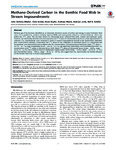Methane-Derived Carbon in the Benthic Food Web in Stream Impoundments

View/
Date
2014Author
Mbaka, John Gichimu
Mbaka, John Gichimu
Somlai, Celia
Ko¨pfer, Denis
Maeck, Andreas
Lorke, Andreas
Scha¨fer, Ralf B.
Metadata
Show full item recordAbstract
Methane gas (CH4) has been identified as an important alternative source of carbon and energy in some freshwater food
webs. CH4 is oxidized by methane oxidizing bacteria (MOB), and subsequently utilized by chironomid larvae, which may
exhibit low d13C values. This has been shown for chironomid larvae collected from lakes, streams and backwater pools.
However, the relationship between CH4 concentrations and d13C values of chironomid larvae for in-stream impoundments is
unknown. CH4 concentrations were measured in eleven in-stream impoundments located in the Queich River catchment
area, South-western Germany. Furthermore, the d13C values of two subfamilies of chironomid larvae (i.e. Chironomini and
Tanypodinae) were determined and correlated with CH4 concentrations. Chironomini larvae had lower mean d13C values (2
29.2 to 225.5 %), than Tanypodinae larvae (226.9 to 225.3 %). No significant relationships were established between CH4
concentrations and d13C values of chironomids (p.0.05). Mean d13C values of chironomid larvae (mean: 226.8%, range: 2
29.2% to 225.3%) were similar to those of sedimentary organic matter (SOM) (mean: 228.4%, range: 229.3% to 227.1%)
and tree leaf litter (mean: 229.8 %, range: 230.5% to 229.1%). We suggest that CH4 concentration has limited influence
on the benthic food web in stream impoundments.
